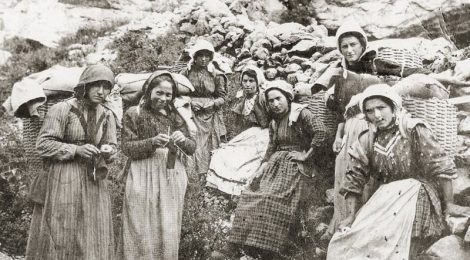
A bit of History – Le portatrici carniche
Many heroic deeds have been commemorated during the centenary of World War I but there is one aspect that relates to the Carnic Alps (in Friuli) that is not well known: the role played by the Carnic women carriers.
Between August 1915 and October 1917 women from villages near the Austrian border, who knew the terrain well, were recruited as auxiliaries by the Italian army to carry on their back food supplies, medicines, tools and munitions to the Alpine soldiers defending the border. Some 10-12,000 men were deployed on the mountains, but there were no roads between the stores and their location.
Around 1000 women ranging in age between 12 and 60 were recruited to carry all supplies in conical wicker baskets on their shoulders, weighing 30-40 kg. The difference in height between valley and mountain ranged between 600 and 1200m. For this, they earned the equivalent of 3 euro a trip, which took all day. Some even knitted while walking or while resting! And as their husbands were away fighting, the women also had to take care of the cows and the children when they got home at night.
At Timau, a border village in Friuli, a monument was inaugurated in 1992 to commemorate these carriers, and on 1 October 1997 the then President of Italy Oscar Luigi Scalfaro visited Timau to award a war medal to the daughter of Maria Plozner, who had been killed “in action” in 1916.
***
In occasione del centenario della I Guerra Mondiale sono stati commemorati numerosi gesti eroici, ma ve n’è uno legato alle Alpi Carniche (in Friuli) che non è ben conosciuto: il ruolo delle portatrici carniche.
Tra agosto 1915 e settembre 1917 donne residenti nei villaggi confinanti con l’Austria, che conoscevano bene il terreno, furono reclutate come ausiliarie dall’Esercito italiano per trasportare sulle spalle viveri, medicine, attrezzi e munizioni ai soldati che difendevano il confine. Sulle montagne erano stanziati circa 10-12.000 Soldati, ma non c’erano strade tra le montagne e le valli dove si trovano i rifornimenti.
Un migliaio di donne tra i 12 e i 60 anni di età fu quindi reclutato per il trasporto di tutto il necessario in gerla. Cariche, le gerle pesavano tra i 30 e i 40 chili. Il dislivello tra la valle e la montagna variava tra i 600 e i 1.200 metri. Per ogni viaggio la portatrice guadagnava l’equivalente di 3 euro ed il viaggio durava tutto il giorno. Alcune facevano pure la maglia per strada o durante la sosta! E siccome i mariti erano via a combattere, le donne dovevano pure occuparsi delle mucche e dei figli una volta rientrate.
Nel 1992 un monumento dedicato alle portatrici carniche fu inaugurato a Timau, paese di confine in Friuli, e il 1° ottobre 1997 l’allora presidente della Repubblica Oscar Luigi Scalfaro si recò a Timau per consegnare una medaglia d’oro al valor militare alla figlia di Maria Plozner, portatrice uccisa da un soldato austriaco nel 1916.
Yvette Devlin
